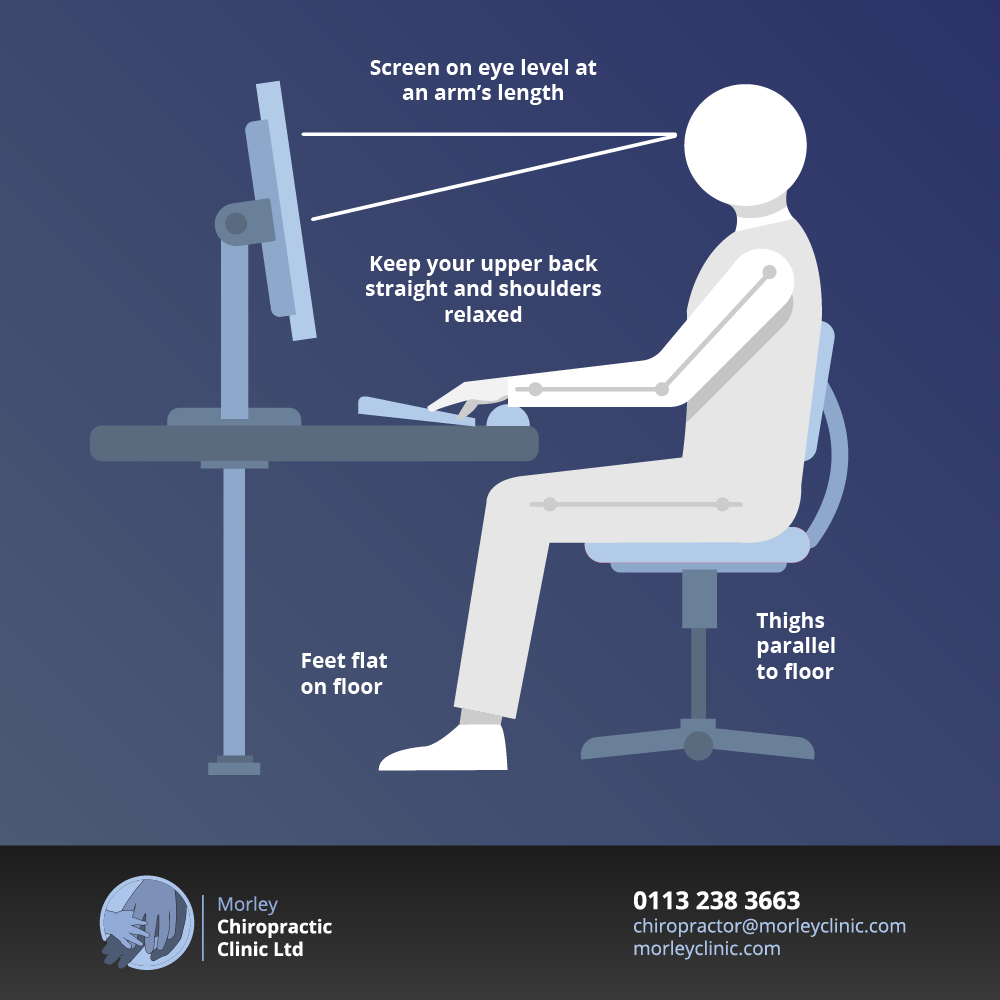As more and more industry systems and processes become automated, more people than ever are working in an office. The knock-on effect of this is that more people are living more and more sedentary lives. This means not only a lack of physical work but a general lack of physical effort and exercise, which translates as spending more and more time sitting. However, leading such seated lives has been reported to have some very alarming health effects. But desk jobs aren’t going anywhere, therefore, as chiropractors for over 20 years, we wanted to give some advice and general information about how to properly sit at your desk.
What Are The Negative Effects of Poor Desk Posture?
There are a frankly intimidating number of negative health effects that can be caused by sitting too much, which are only added to or exacerbated by sitting poorly. As a species, we are meant to move and move often. And there is research to show that rather than sitting in a chair we should instead be adopting what has been known as a third world squat. However, that’s an article in its own right.
With regards to sitting excessively and poorly, negative health effects can include:
- Poor circulation
- Fatigue
- Forward head posture
- Shoulder and back pain
- Rounded shoulders
- Body aches and pains
- Muscle fatigue
- Headache
- Increased risk of cancer
- Increased risk of heart disease, diabetes, stroke, high blood pressure, and high cholesterol
- Poor Circulation
- Constricted Nerves
- Poor Digestion
In fact, an analysis of 13 studies carried out on sitting time and activity levels found that those who sat for more than eight hours a day with no physical activity had a risk of dying similar to the risks of dying posed by obesity and smoking.
Now we know what the negative effects of sitting are, we’ll talk about what to do about it.
How to Sit at Your Desk Correctly
As with most things pertaining to health, there is no one right way of doing things, or rather there is your correct way of doing things. The below is a textbook checklist for sitting correctly, but it is important to find your own version of this that enables you to sit comfortably for a length of time.
- Ensure that your feet are flat on the floor (use a riser if you have to) and your knees are slightly below hip level.
- Keep the natural curve in your lower back, and hips pushed back in the chair.
- Keep your upper back straight and not ‘hunched’.
- The back of the chair should be somewhat reclined at a 100- to 110-degree angle.
- Ensure the keyboard is close and directly in front of you.
- Keep your shoulders relaxed and that the top of your screen is a couple of inches above eye level (it may be worth investing in a screen riser).
- Sit at least an arm’s length away from the computer screen.
- Try and avoid crossing your legs – crossing your legs has been linked to increased blood pressure, poor posture and even nerve damage.

Keep in mind that sitting correctly is something to be worked on. There is a chance that your core muscles will need to develop and strengthen in order to help you sit as described above for a period of time.
Alternatives to Sitting
Of course, chairs are not the only way to sit. As people have become more conscious of their health and the benefits of correct posture, many alternatives to the traditional office chair have emerged. The idea behind most of these chairs is to eliminate the back support found in normal office chairs, instead forcing you to use and rely on your core muscles to support your spine.
- Balance Ball Chair – uses a ‘gym ball’ instead of a normal seat for an unstable seat forcing you to engage your core.
- If the above stretches your budget a bit, why not just use the exercise ball on its own?
- Balance stool – slightly more stable than the balance ball chair, but s similar principle.
- Kneeling chair – these take away the reliance of your legs as a stabiliser requiring you to sit in a kneeling position.
- Walking Desk – you can now purchase desks built over treadmills. The idea here is obvious, to keep a steady motion, in theory counteracting the negative effects of sitting for long stretches of time.
Sitting vs Standing Desk
A hugely popular alternative to the traditional office desk is the standing desk. These have skyrocketed in popularity in recent years and reportedly come with a number of benefits. Not least of which include burning more calories when compared to sitting, lowering the risk of heart disease, reducing lower back pain (assuming you have ‘good’ posture) and even increasing your life span.
However, they are not a miracle cure. As alluded to above, if your posture is poor you may develop more knee and lower back pain from standing where you previously sat. There is also an argument to make that tasks which require fine motor skills are better performed sitting rather than standing. There have also been tests which showed that people who are sitting were better at recalling lists of words and numbers. This makes sense purely from a concentration point of view as they only have to focus on one thing.
How To Fix Desk Posture
If you follow the instructions above for sitting at your desk then you are sitting in the most anatomically safe way, and thus minimise the risk of any long-term damage. But there are other things you can do to help improve things further. One common piece of advice is to stand up and move around every 30 minutes. This may include a trip to the toilet, or to make yourself a drink.
But there are also other things you can do while staying in your seat. The issue of sitting for extended periods of time has been recognised and so there are numerous yoga instructors who have devised routines to encourage mobility and blood flow while allowing you to sit at your desk.
If you are having long-term issues, or are worried about your posture on long-term health, just drop us a line! Morley Chiropractic Clinic has been operating for over 20 years. We are registered with the British Chiropractic Association, Royal College of Chiropractors and General Chiropractic Council. During this time we have treated countless people for a range of issues.












